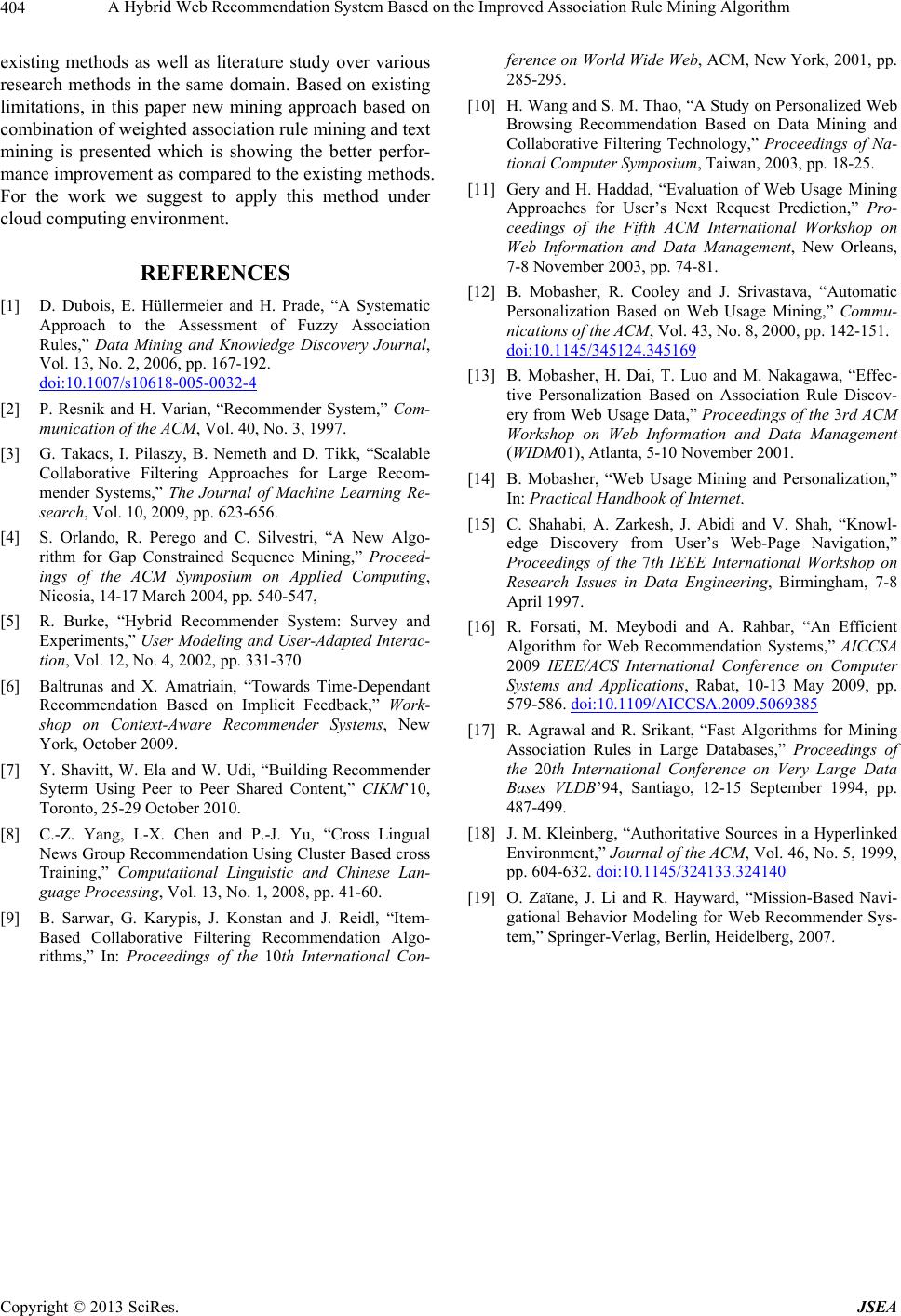
A Hybrid Web Recommendation System Based on the Improved Association Rule Mining Algorithm
Copyright © 2013 SciRes. JSEA
404
existing methods as well as literature study over various
research methods in the same domain. Based on existing
limitations, in this paper new mining approach based on
combination of weighted association rule mining and text
mining is presented which is showing the better perfor-
mance improvement as compared to the existing methods.
For the work we suggest to apply this method under
cloud computing environment.
REFERENCES
[1] D. Dubois, E. Hüllermeier and H. Prade, “A Systematic
Approach to the Assessment of Fuzzy Association
Rules,” Data Mining and Knowledge Discovery Journal,
Vol. 13, No. 2, 2006, pp. 167-192.
doi:10.1007/s10618-005-0032-4
[2] P. Resnik and H. Varian, “Recommender System,” Com-
munication of the ACM, Vol. 40, No. 3, 1997.
[3] G. Takacs, I. Pilaszy, B. Nemeth and D. Tikk, “Scalable
Collaborative Filtering Approaches for Large Recom-
mender Systems,” The Journal of Machine Learning Re-
search, Vol. 10, 2009, pp. 623-656.
[4] S. Orlando, R. Perego and C. Silvestri, “A New Algo-
rithm for Gap Constrained Sequence Mining,” Proceed-
ings of the ACM Symposium on Applied Computing,
Nicosia, 14-17 March 2004, pp. 540-547,
[5] R. Burke, “Hybrid Recommender System: Survey and
Experiments,” User Modeling and User-Adapted Interac-
tion, Vol. 12, No. 4, 2002, pp. 331-370
[6] Baltrunas and X. Amatriain, “Towards Time-Dependant
Recommendation Based on Implicit Feedback,” Work-
shop on Context-Aware Recommender Systems, New
York, October 2009.
[7] Y. Shavitt, W. Ela and W. Udi, “Building Recommender
Syterm Using Peer to Peer Shared Content,” CIKM’10,
Toronto, 25-29 October 2010.
[8] C.-Z. Yang, I.-X. Chen and P.-J. Yu, “Cross Lingual
News Group Recommendation Using Cluster Based cross
Training,” Computational Linguistic and Chinese Lan-
guage Processing, Vol. 13, No. 1, 2008, pp. 41-60.
[9] B. Sarwar, G. Karypis, J. Konstan and J. Reidl, “Item-
Based Collaborative Filtering Recommendation Algo-
rithms,” In: Proceedings of the 10th International Con-
ference on World Wide Web, ACM, New York, 2001, pp.
285-295.
[10] H. Wang and S. M. Thao, “A Study on Personalized Web
Browsing Recommendation Based on Data Mining and
Collaborative Filtering Technology,” Proceedings of Na-
tional Computer Symposium, Taiwan, 2003, pp. 18-25.
[11] Gery and H. Haddad, “Evaluation of Web Usage Mining
Approaches for User’s Next Request Prediction,” Pro-
ceedings of the Fifth ACM International Workshop on
Web Information and Data Management, New Orleans,
7-8 November 2003, pp. 74-81.
[12] B. Mobasher, R. Cooley and J. Srivastava, “Automatic
Personalization Based on Web Usage Mining,” Commu-
nications of the ACM, Vol. 43, No. 8, 2000, pp. 142-151.
doi:10.1145/345124.345169
[13] B. Mobasher, H. Dai, T. Luo and M. Nakagawa, “Effec-
tive Personalization Based on Association Rule Discov-
ery from Web Usage Data,” Proceedings of the 3rd ACM
Workshop on Web Information and Data Management
(WIDM01), Atlanta, 5-10 November 2001.
[14] B. Mobasher, “Web Usage Mining and Personalization,”
In: Practical Handbook of Internet.
[15] C. Shahabi, A. Zarkesh, J. Abidi and V. Shah, “Knowl-
edge Discovery from User’s Web-Page Navigation,”
Proceedings of the 7th IEEE International Workshop on
Research Issues in Data Engineering, Birmingham, 7-8
April 1997.
[16] R. Forsati, M. Meybodi and A. Rahbar, “An Efficient
Algorithm for Web Recommendation Systems,” AICCSA
2009 IEEE/ACS International Conference on Computer
Systems and Applications, Rabat, 10-13 May 2009, pp.
579-586. doi:10.1109/AICCSA.2009.5069385
[17] R. Agrawal and R. Srikant, “Fast Algorithms for Mining
Association Rules in Large Databases,” Proceedings of
the 20th International Conference on Very Large Data
Bases VLDB’94, Santiago, 12-15 September 1994, pp.
487-499.
[18] J. M. Kleinberg, “Authoritative Sources in a Hyperlinked
Environment,” Journal of the ACM, Vol. 46, No. 5, 1999,
pp. 604-632. doi:10.1145/324133.324140
[19] O. Zaϊane, J. Li and R. Hayward, “Mission-Based Navi-
gational Behavior Modeling for Web Recommender Sys-
tem,” Springer-Verlag, Berlin, Heidelberg, 2007.